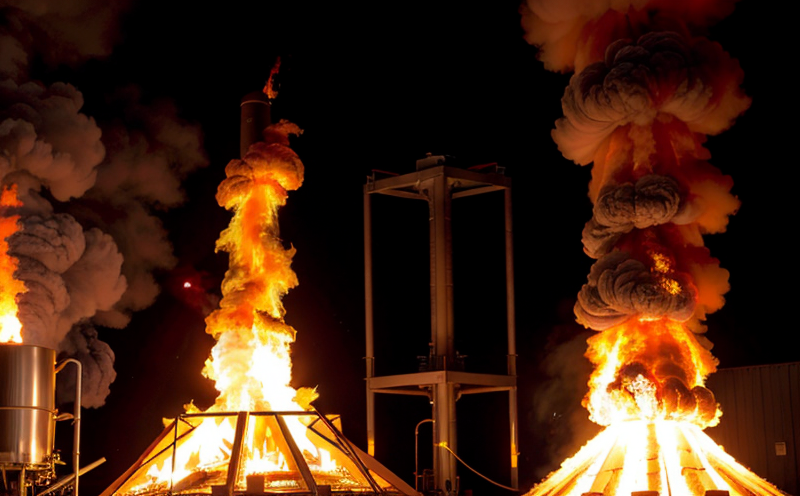Foam Material Flammability Testing
The foam material flammability testing service offered by our laboratory plays a crucial role in ensuring product safety and compliance with industry regulations. Foam materials are widely used across various sectors including automotive, furniture, bedding, and packaging due to their insulating properties and comfort. However, the flammability of these materials can pose significant risks if not properly evaluated and managed.
Our testing service focuses on determining how foam materials behave under exposure to fire or heat, which is essential for predicting potential hazards during use. By conducting rigorous tests according to international standards such as ISO 13467-2:2015 and ASTM E84-18a, we provide detailed reports that help clients make informed decisions about their product safety.
Flammability testing involves several key steps, including specimen preparation. Specimens must be cut to standard sizes according to the specified test method, which ensures consistency across all samples being tested. The specimens are then placed in a specially designed oven where they are exposed to controlled levels of heat and flame for a set duration.
The results of these tests provide valuable insights into various aspects of foam material performance under fire conditions. This information is critical not only for regulatory compliance but also for improving product design and enhancing overall safety features. Understanding the specific characteristics of foam materials allows manufacturers to optimize their formulations, thereby reducing risks associated with improper handling or misuse.
For instance, one important aspect examined during flammability testing is the flame spread index (FSI), which measures how quickly flames travel across a given surface area. Another key parameter is smoke density, indicating the amount of smoke produced by burning materials. These factors are crucial when assessing fire safety risks and ensuring compliance with relevant regulations.
Our laboratory adheres strictly to internationally recognized guidelines like ISO 13467-2:2015 and ASTM E84-18a to ensure accuracy and reliability in our testing procedures. Compliance with these standards guarantees that the results obtained from our tests are credible and accepted by regulatory bodies worldwide.
By leveraging advanced instrumentation and experienced technical staff, we offer comprehensive foam material flammability testing services tailored to meet diverse client needs. Our commitment to excellence ensures that every test conducted meets high-quality standards while providing actionable data for informed decision-making processes within organizations.
Applied Standards
Foam material flammability testing is governed by several international standards designed to ensure consistent evaluation methods and accurate results. The primary standard used in this service is ISO 13467-2:2015, which provides guidelines for horizontal burning tests on flexible cellular materials such as polyurethane foam.
- ISO 13467-2:2015 specifies the procedure for conducting flame spread index (FSI) measurements and smoke density determinations using a narrow gap furnace under controlled conditions.
- ASTM E84-18a sets forth additional parameters including the smoke obscuration factor, which quantifies the reduction in light transmission due to smoke formation during combustion.
These standards are essential for ensuring that foam materials meet specified fire safety requirements set by regulatory authorities. By adhering strictly to these guidelines throughout our testing process, we guarantee accurate and reliable results that can be trusted by manufacturers and end-users alike.
Benefits
- Enhanced Product Safety: Ensures foam materials comply with strict fire safety regulations, protecting consumers from potential hazards.
- Informed Decision-Making: Provides valuable data on flame spread and smoke generation properties, helping manufacturers improve product designs.
- Regulatory Compliance: Meets international standards like ISO 13467-2:2015 and ASTM E84-18a, ensuring compliance with local and global regulations.
- Cost Savings: Identifies issues early in the development process, reducing costly rework or recall efforts later on.
Foam material flammability testing is an indispensable tool for quality managers, compliance officers, R&D engineers, and procurement professionals. It enables stakeholders to make data-driven decisions that prioritize both safety and efficiency in their operations.
Customer Impact and Satisfaction
Our foam material flammability testing service has significantly impacted customer satisfaction by providing reliable and actionable insights into the fire performance of various foam materials. Clients benefit from our expertise in interpreting test results, offering tailored recommendations for improving product safety.
- Increased Confidence: With accurate data supporting their decisions, customers have greater confidence in the quality and safety of their products.
- Better Decision-Making: Armed with comprehensive information about foam material behavior under fire conditions, clients can optimize formulations and enhance overall product performance.
- Improved Reputation: By ensuring compliance with stringent safety standards, our service helps build trust among consumers and stakeholders alike.
Our commitment to excellence has earned us a reputation for delivering exceptional services that meet the highest expectations of our clients. We strive to exceed their needs through meticulous attention to detail and unwavering dedication to quality.





